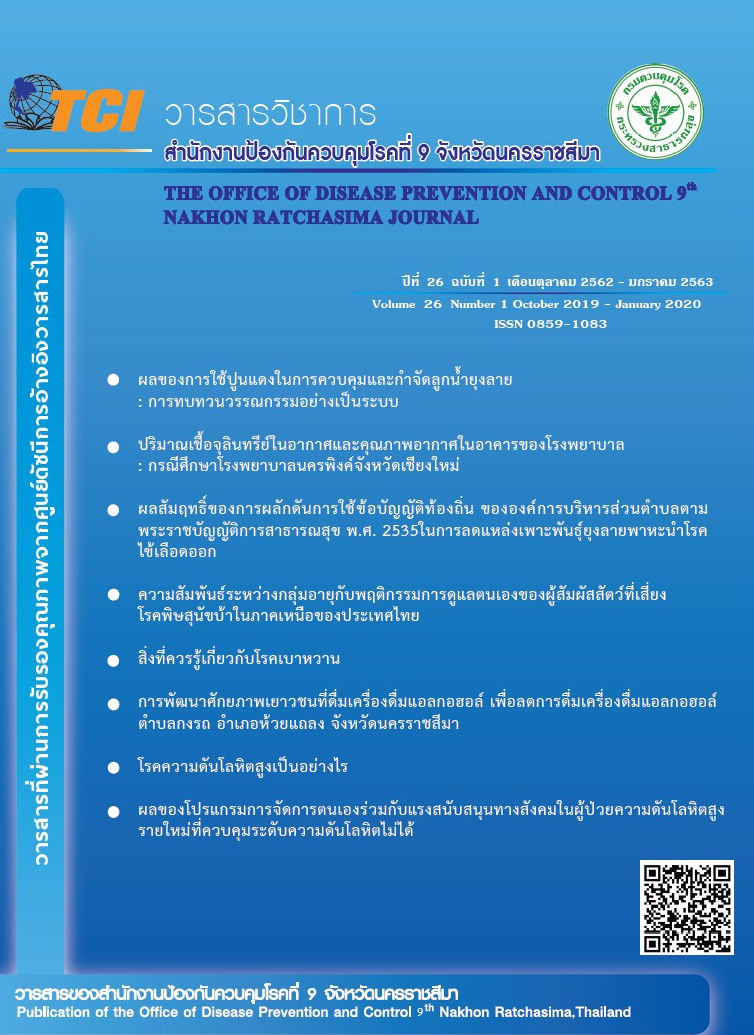Quantity of Bioaerosol and Indoor Air Quality in Hospital : Case Study of Nakornping Hospital, Chiang Mai
Keywords:
Bioaerosal, Indoor Air QualityAbstract
The objective was to study the quantity of bioaerosol and indoor air quality in the hospital and to
study the relationship between the quantity of bioaerosol and indoor air quality. This study was a crosssectional
analytical study. A samples were the outpatient department, Inpatient department, Emergency room,
Tuberculosis clinic and the office in hospital. Use Single Stage Impactor and Indoor Air Quality Monitor
tools. Data analyzed using descriptive statistics and Pearson correlation coefficient. The study indicated that
the highest quantity of bacteria was the emergency room. With an average of 614.69 CFU/m3 which does not pass the standard criteria by Institute of Environmental Epidemiology, Ministry of the Environment
Singapore.(<500 CFU/m3)During the morning, the quantity of bacteria is higher than the afternoon.
Monday was the day when bacteria were found more than Wednesday and Friday. The position that
found the highest bacteria quantity was air inlet position. The highest quantity of fungus was found in the
outpatient department with an average of 650.06 CFU/m3 which does not pass The standard criteria.
During the morning, the quantity of fungus was higher than the afternoon. Wednesday was the day that the
fungus is found more than Monday and Friday. The position that found the highest bacteria quantity was
air inlet position. Indoor air quality, Temperature was negative correlated with the low level of bacteria.
(r = -0.291, p-value <0.05) Carbon dioxide was positive correlated with the medium level of bacteria.
(r = 0.353, p-value <0.05) Relative humidity was positive correlated with the medium level of fungus.
(r = 0.465, p-value <0.05) Oxygen, Carbon dioxide, Temperatures were negative correlated with the low
level of fungus. (r = -0.234, -0.146, -0.107 respectively, p-value <0.05) It was recommended that a
change in the working environment. Especially in the areas of indoor air quality with supervision of indoor
cleanliness, Ventilation to prevent further pathogens in hospitals.
References
และการเปรียบเทียบการทำงานของเครื่องมือเก็บตัวอย่างจุลินทรีย์ในอากาศ [วิทยานิพนธ์ปริญญา
วิทยาศาสตรมหาบัณฑิต]. ขอนแก่น:มหาวิทยาลัยขอนแก่น ; 2548.
2. นงลักษณ์ สุวรรณพินิจและปรีชา สุวรรณพินิจ. จุลชีววิทยาทั่วไป. พิมพ์ครั้งที่ 10. กรุงเทพฯ :
สำนักพิมพ์แห่งจุฬาลงกรณ์ มหาวิทยาลัย; 2557 : 145-149.
3. กรมควบคุมโรค. แผนงานควบคุมโรคติดเชื้อในโรงพยาบาล ปี 2560-2564. [ออนไลน์].2560. [เข้าถึงเมื่อ 27
พฤศจิกายน 2560].เข้าถึงได้จาก/http://122.155.1.141/site2/download-src.
php?did=30592.
4. กระทรวงสาธารณสุข. ระบบรายงาน Health Data Center : HDC. [ออนไลน์].2560 [เข้าถึงเมื่อ 16ตุลาคม 2560].
เข้าถึงได้จาก/https://hdcservice.moph.go.th/hdc/main/index.php.
5. Becton Dickinson and Company. BBL™ Sabouraud Dextrose Agar. [ออนไลน์]. 2015.
[เข้าถึงเมื่อ 16ตุลาคม 2560]. เข้าถึงได้จาก/http://legacy.bd.com/ds/technicalCenter/inserts/
L007492(12).pdf
6. บัญญัติ สุขศรีงาม. จุลชีววิทยาทั่วไป. ใน:บัญญติ สุขศรีงาม, บรรณาธิการ. จุลชีวทยาทั่วไป พิมพ์ครั้ง4.
กรุงเทพฯ: โอเดียนสโตร์. 2534.
7. โสภณ คงสำราญ.แบคทีเรียทางการแพทย์, พิมพ์ครั้งที่ 1. กรุงเทพฯ : โรงพิมพ์พิฆเณศ, 2524.
8. จักรพงษ์ นิมานะ และคณะ. การปนเปื้อนจุลินทรีย์ในอากาศห้องปฏิบัติการ คณะวิทยาศาสตร์
มหาวิทยาลัยพายัพ. วารสารวิทยาศาสตร์มหาวิทยาลัยขอนแก่น 2557 ; 42 : 341-349.
9. สุวัฒน์ ดำนิล. การสำรวจระดับความเข้มข้นและการจำแนกชนิดของแบคทีเรียและเชื้อราในอากาศ
ภายในอาคารของ โรงพยาบาลศิริราช[วิทยานิพนธ์/ปริญญาวิทยาศาสตรมหาบัณฑิต]. กรุงเทพฯ:
มหาวิยาลัยมหิดล; 2552.

Downloads
Published
How to Cite
Issue
Section
License
บทความที่ลงพิมพ์ในวารสารวิชาการสำนักงานป้องกันควบคุมโรคที่ 9 จังหวัดนครราชสีมา ถือว่าเป็น
ลิขสิทธิ์ สำนักงานป้องกันควบคุมโรคที่ 9 จังหวัดนครราชสีมา


